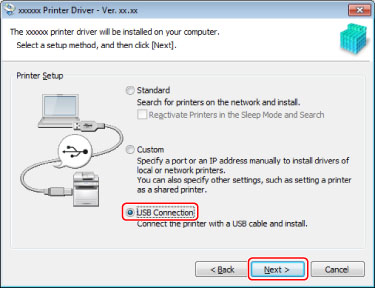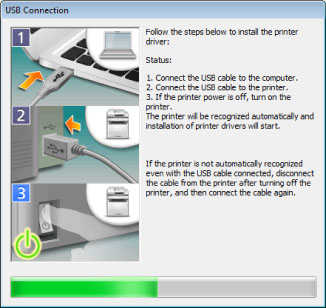Selecting [USB Connection] to Install
This explains the procedure for connecting a device and computer with a USB cable and installing a driver.
 IMPORTANT
IMPORTANTIf connecting by USB and installing, since Canon Driver Information Assist Service cannot be installed simultaneously, you cannot use the device information retrieval function as is. If you want to use it, install the Canon Driver Information Assist Service after installing the driver. However, if connected by USB, you may not be able to use the device information retrieval function, depending on the device and environment you are using.
Prerequisites
Confirm that the following conditions are satisfied. Complete the preparation operations.
Installation of the optional USB interface board (if required with the device you are using)
Page description language selection (plug & play) function setting of the device (if required with the device you are using)
For details, refer to the manual of the device.
When starting the computer, log on as a member of Administrators.
[Desktop] screen display (when using Windows 8/8.1/Server 2012/Server 2012 R2)
Procedure
1.
Turn off the device.
2.
Start the installer.
If you are using an installer downloaded from the web site
Double-click the downloaded file to decompress it. If the installer does not start automatically after it is decompressed, double-click [Setup.exe].
If you are using the accompanying CD-ROM
(1) Set the CD-ROM in the computer → click [Installation].
(2) In the [Installation] screen, confirm the driver → click [Installation].
If the CD-ROM menu is not displayed, click "Open details."
In the following procedure, start the installer.
When the [Tap to choose what happens with this disc.] message is displayed: Click the message → click [Run MInst.exe].
When the [AutoPlay] dialog box is displayed: Click [Run MInst.exe].
When Windows Explorer is displayed: Double-click [MInst.exe].
When nothing is displayed (Windows10): From Explorer, double-click the CD icon in [This PC] > [Devices and drives].
When nothing is displayed (Windows 8/8.1/Server 2012/Server 2012 R2): Click Explorer in the [Desktop] screen → double-click the CD icon in [Computer].
When nothing is displayed (Windows Vista/7/Server 2008/Server 2008 R2): Double-click the CD-ROM icon in [ ] (Start) > [Computer].
] (Start) > [Computer].
 ] (Start) > [Computer].
] (Start) > [Computer].If the above [MInst.exe] does not exist:
Double-click [Setup.exe].
32-bit version: 32BIT\Setup.exe
64-bit version: x64\Setup.exe
3.
Read the license agreement → click [Yes].
4.
Select [USB Connection] → click [Next].
Proceed with the installation according to the instructions on the screen.

5.
When the following screen appears, connect the device and computer with a USB cable → turn on the device.

Proceed with the installation according to the instructions on the screen.
If installation fails in the above screen, click "Open details."
Reinstall after performing the following procedure.
(1) Connect the device and computer with a USB cable → turn the device on.
(2) Display the device manager.
Windows Vista/Server 2008: [Control Panel] > [System and Maintenance] > [Device Manager].
Windows 7/8/8.1/Server 2008 R2/Server 2012/Server 2012 R2: [Control Panel] > [Hardware and Sound] > [Device Manager].
Windows 10: [Settings] > [Devices] > [Printers & scanners] > [Device Manager] at the bottom of the screen.
(3) Right-click the name of the target device displayed in [Other devices] → click [Delete].
(4) Confirm the device name.
Canon + <model name>
6.
Click [Restart] (or [Exit]).
The installed device is displayed in [Devices and Printers], [Printers and Faxes], or [Printers] in the Windows Control Panel.
In Windows 10, the installed device is displayed in [Settings] > [Devices] > [Printers & scanners] > [Printers].